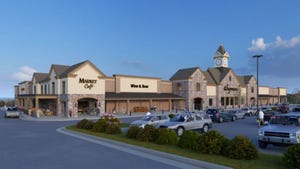THE SOLAR SOLUTION
The soaring costs of heating, ventilating, air conditioning and refrigerating a supermarket may be causing retailers to seek answers from the heavens. Ironically, some are finding a solution there, in the form of solar energy.With their enormous energy needs and vast roof space, a handful of supermarkets have realized that they're ideal candidates for collecting and converting the sun's ultraviolet
September 19, 2005
Julie Gallagher
The soaring costs of heating, ventilating, air conditioning and refrigerating a supermarket may be causing retailers to seek answers from the heavens. Ironically, some are finding a solution there, in the form of solar energy.
With their enormous energy needs and vast roof space, a handful of supermarkets have realized that they're ideal candidates for collecting and converting the sun's ultraviolet rays into immediately consumable energy.
In addition to representing a more cost-efficient energy source, the option is helping retailers create a more environmentally friendly image. "Most electricity is produced by burning coal, but if you create electricity through the power of the sun, you'll end up with the same product without polluting the environment," said Steve Cohen, manager, architectural glass, RWE Schott Solar, Elmsford, N.Y., a manufacturer of solar panels. "That is solar energy's main attraction."
Earlier this month, Woodlands Market -- a single-store gourmet specialty retailer based in Kentfield, Calif. -- became the largest solar-powered supermarket in California when Novato, Calif.-based SolarCraft Services retrofitted its 19,000-square-foot roof with a 100-kilowatt system comprised of 746 solar modules. The store's solar energy system has the ability to generate about 25% of the store's annual energy needs, according to Chris Bunas, photovoltaic systems director, SolarCraft.
Each year the system will spare the environment more than 145 tons of harmful greenhouse gases, and within the next 30 years the pollution saved will be the equivalent of taking 683 vehicles off the road, Woodlands reported.
"Solar is a fantastic idea and it was an easy decision for us," said Sue Santa, co-owner, Woodlands Market. "Being an independent affords us the freedom to let progressive ideas come to fruition."
The process began about two years ago as Santa began noticing solar panels around the community. "It wasn't as intimidating [as we had anticipated], so we decided to make the commitment," she said. "We found that, with rebates, we'll pay the system off in six to seven years, and it will offer a substantial savings. [Supermarkets] shouldn't be intimidated by the process; everyone can accomplish this."
The installation process lasted four months and did not interfere with the store's operation, according to Santa. That was important to her and her co-owner brother since the store has remained open every day of the year since it opened in 1986. About 95% of solar stores are existing locations that have been retrofitted with solar panels, according to Bunas.
Though Woodlands' flexibility as an independent helped bring about its solar investment, solar projects are also making sense for some mega-retailers. In July, Wal-Mart Stores, Bentonville, Ark., opened an experimental, environmentally friendly supercenter in McKinney, Texas, to much fanfare. Wind, waste oil and sun are among the resources it's using to power the store. (See "The Greening of Wal-Mart," SN, Aug. 15, 2005, Page 43.)
At the supercenter, solar power is collected and converted by 7,500 square feet of photovoltaic solar panels, provided by RWE Schott Solar and Solar Integrated Technologies, Los Angeles. The panels have been installed on the supercenter's Garden Center canopy, the roof of its Tire and Lube Express center, the front facade of the store and the roof of its entry vestibule. Solar panels are also used to light traffic signs in the parking lot.
"Solar power is inverted and fed directly into the main [energy] distribution of the store," said Tara Stewart, spokeswoman for Wal-Mart, adding that the system generates about 3% of the supercenter's energy needs. Since July, Wal-Mart's McKinney solar system has produced more than 10,000 kilowatts of energy, according to www.walmartfacts.com.
Wal-Mart will open a similarly equipped supercenter in Aurora, Colo., this fall.
Another new solar-powered store was opened in July in Princeton, N.J., by Austin, Texas-based Whole Foods Market. The 12,500 square feet of solar panels installed on its roof produce enough power to generate 15% of the store's energy needs.
Whole Foods is no newcomer to solar power, with at least four of its stores now using the energy source. (Whole Foods declined to provide exact figures.) Its first solar-powered store opened in 2002 in Berkeley, Calif., becoming the first supermarket to use solar energy, according to the retailer.
At the Berkeley store, Whole Foods created a 33-kilowatt solar electric system, with help from Princeton Energy Systems, Clifton Heights, Pa.; PowerLight, Berkeley, Calif.; and Nextek Power System, Hauppauge, N.Y. The solar array installed on the roof covers 2,860 square feet and solar energy is dedicated to powering the store's fluorescent lighting system.
REDUCING UP-FRONT COSTS
With its considerable savings potential, why haven't more supermarkets adopted solar energy systems?
In a word, cost. "The disadvantage to [a solar energy system] is the up-front costs," SolarCraft's Bunas said. "There are ways to [reduce] the expense with financing and federal and state rebates. Solar power is a long-term investment; these systems are designed to run for 40 years."
In California, for instance, an up-front rebate of $2.80 per watt is available, he explained. Woodlands Market was able to secure a $4 per watt rebate from the state because it was part of an earlier rebate program, according to Bunas. The rebate paid for half of Woodlands' $900,000 solar energy system, he said.
Santa also took advantage of a finance option SolarCraft offered, she said. Solar vendors often offer finance options that cost the same or less than what the retailer was paying for its utility bill, according to Bunas. This cannot be confirmed by Santa since she has yet to receive her first post-installation utility bill.
Woodlands' system has the ability to generate solar power even on cloudy or foggy days because clouds do not prevent the ultraviolet rays from reaching the panels. "In a light fog the system will produce 70% to 80%" of its optimal energy output, Bunas said.
The solar panels on Woodlands' roof produce direct current (DC), which is fed into inverters, Bunas explained.
"The inverters are sort of the brains of the system," he said. "They convert DC electricity into alternating current [AC] so that the building can use it." The inverters also condition the electricity so it becomes "cleaner" than what the utility can provide. In this case clean means a smooth, constant flow of energy, Bunas explained. The inverters are also used to monitor utility power.
Maintenance of the solar system is minimal, Santa said. SolarCraft will clean the panels every two months by hosing them down, she explained. Also, the panels are under warranty for 25 years. "The system will experience a slight degradation over the long term, but it will continue to produce full power for at least 20 years," Bunas said.
SolarCraft also monitors the store's solar energy production and makes it available via computer. Woodlands Market shares the information with shoppers through a kiosk installed in the store. "The [kiosk] makes customers feel like they're part of the whole [solar process]," Santa said. In addition to the in-store kiosk, this information is displayed on a computer in Santa's office.
Woodlands unveiled the kiosk at a recent event that celebrated the new solar energy system. During the celebration, the store distributed canvas shopping bags, sunflowers and fresh squeezed orange juice. "We received tremendous feedback," Santa said. "We always lead the charge in innovative ideas, and our customers love that."
Shopping in Natural Light
Choices Markets, a six-store natural food retailer based in Vancouver, British Columbia, is not employing solar panels at its new environmentally focused store, Choice White Rock. But it is using quite a few other energy-saving strategies.
That includes natural light. At Choices White Rock, which opened Sept. 8 in South Surrey, British Columbia, the store's arched ceiling has a skylight that circles the store to ensure as much natural light as possible enters the building. In addition to lowering its energy costs, the feature improves the shopping experience.
"You can actually see the fruits and vegetables you are buying in natural light," said Steve Lockhart, store manager, Choices White Rock, in a statement. "We tried at every turn to bring the outside in, including a 16-foot orange tree in the center of the produce section."
The store also features a heating reclaim system that captures the heat generated from refrigerators and coolers, and pumps it back into the store. Its refrigerator units have temperature settings that are monitored and can instantly be corrected. And the store features its own recycling center, as well as an organic waste pick-up to divert excess waste from landfills.
"We have thought of everything in building this store from the ground up," said Mark Vickars, chief executive officer, Choices Markets, in a statement. "Our mission was to close the loop, and whatever goes into the store comes out of the store, in the most environmentally friendly way imaginable. Frankly, I don't think we have just closed the loop -- I think we've tied it tight."
JULIE GALLAGHER
About the Author
You May Also Like






